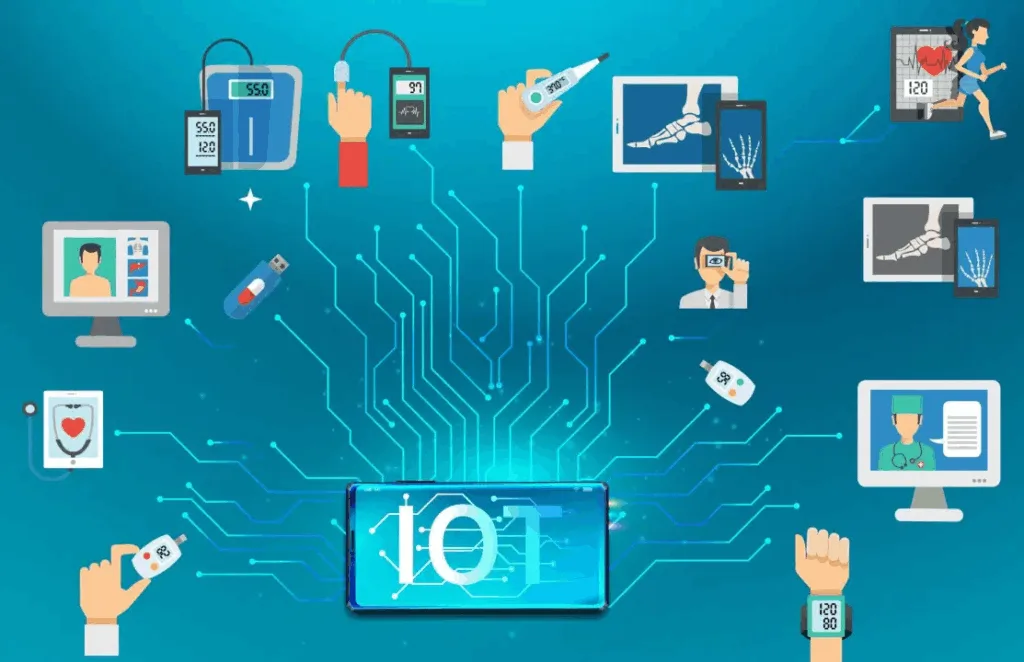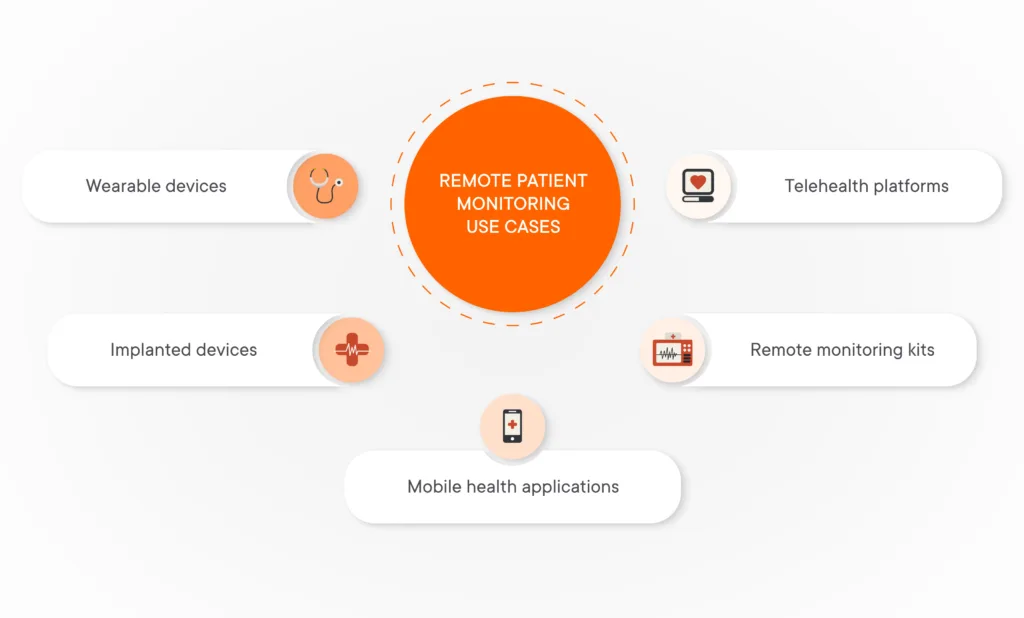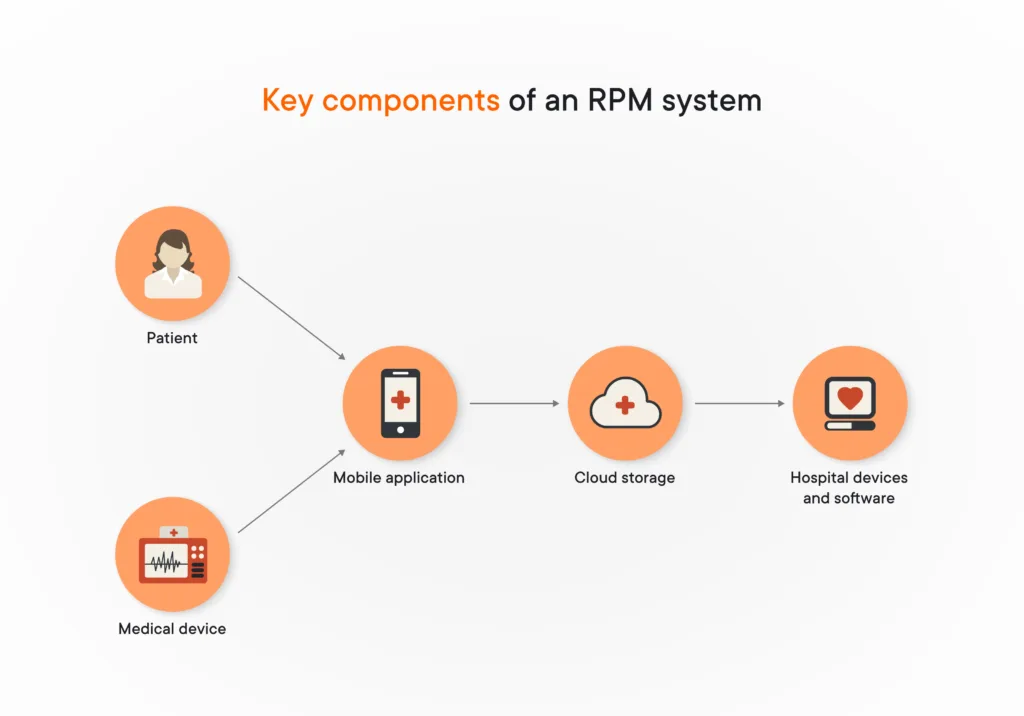
The integration of Internet of Things (IoT) technology has brought remarkable progress to the healthcare industry, especially in the area of remote patient monitoring (RPM). These smart devices empower healthcare professionals to keep track of patient health in real-time—without requiring patients to visit medical facilities.
In this article, we’ll explore the major benefits of IoT devices in RPM and how they’re reshaping patient care, reducing costs, and enhancing overall healthcare delivery.
Transforming Healthcare: The Benefits of IoT devices in RPM
IoT devices are playing a pivotal role in modernizing patient monitoring. Traditionally, tracking patient health meant frequent clinic visits, but IoT-enabled devices eliminate that need. Equipped with sensors, these tools can continuously collect vital health data such as blood pressure, glucose levels, and heart rate.
This data is transmitted in real time to healthcare providers, allowing them to monitor patients remotely and respond proactively. As a result, patients benefit from more convenient care—without leaving their homes—while hospitals and clinics experience reduced strain on resources.
Elevating Patient Care Through Real-Time Health Insights
One of the standout advantages of IoT in remote monitoring is its ability to deliver real-time health data. This steady flow of information enables healthcare providers to act quickly and make well-informed decisions.
If a patient’s vitals begin to show concerning changes, doctors can intervene immediately—adjusting medications or treatments to prevent further complications. This ability to act fast not only enhances patient safety but also ensures a higher level of personalized care, helping to prevent emergencies before they arise.
Reducing Healthcare Costs Through Proactive Monitoring
IoT-powered RPM also plays a critical role in cutting healthcare costs. For providers, the reduced need for in-person consultations and hospital admissions means lower operational expenses. For patients, fewer hospital visits and less travel translate to direct savings.
Moreover, real-time monitoring allows early detection of potential health issues, which can prevent expensive treatments or emergency procedures later. This shift from reactive to proactive care improves outcomes while also making healthcare more cost-effective for everyone involved.
Better Health Outcomes with Continuous Condition Monitoring
For patients managing chronic illnesses such as hypertension, diabetes, or heart disease, continuous monitoring is a game changer. IoT devices allow healthcare providers to track a patient’s condition 24/7 and respond quickly to any deviations.
This uninterrupted stream of data helps in fine-tuning treatment plans on the fly, reducing the chance of complications and hospital readmissions. It also empowers patients by giving them the tools and insights to actively participate in managing their own health, leading to improved quality of life and long-term outcomes.
How IoT Devices Help Minimize Hospital Readmissions and Emergency Room Visits
Hospital readmissions and emergency visits remain major hurdles in managing chronic illnesses. IoT devices are proving instrumental in addressing these challenges by supplying healthcare providers with continuous streams of patient data. This real-time monitoring helps detect early signs of health deterioration, allowing medical professionals to intervene before conditions worsen.
With proactive alerts and timely responses, patients can be managed effectively at home, reducing the need for costly and potentially harmful hospital visits. By keeping health conditions stable through consistent oversight, IoT-enabled remote monitoring plays a critical role in improving patient outcomes and decreasing unnecessary hospital utilization.
Empowering Personalized Healthcare Through IoT Technology
One of the most transformative aspects of IoT in healthcare is its ability to enable highly personalized patient care. These devices gather real-time data specific to each individual, giving medical teams a deep understanding of the patient’s current health status.
Conditions such as hypertension, heart disease, or diabetes can be closely tracked with accurate, ongoing data. As a result, healthcare providers can make timely, well-informed decisions—whether it’s adjusting medication or updating a treatment plan—based on current health trends rather than relying on general assumptions or infrequent checkups. This tailored approach leads to more effective treatment, greater patient satisfaction, and better health outcomes.
Ensuring Data Privacy and Security in IoT-Enabled Remote Monitoring
As remote patient monitoring becomes more widespread, the protection of personal health information is more important than ever. IoT devices handle sensitive medical data, and strong security measures are essential to prevent breaches and unauthorized access.
Today’s IoT healthcare solutions come with advanced safeguards like end-to-end encryption, secure data transmission protocols, and authentication systems to ensure that all health information is shared safely. These features help providers meet strict privacy regulations, such as HIPAA compliance in the U.S., giving patients confidence that their data is protected while benefiting from modern, connected care.
Optimizing Healthcare Delivery with IoT-Driven Remote Monitoring
Beyond patient care, IoT devices are also streamlining day-to-day healthcare operations. By allowing patients to be monitored remotely, these tools minimize the need for routine in-person visits, saving valuable time for both healthcare providers and patients.
Medical staff can track health metrics such as blood pressure, oxygen levels, or heart rate from a distance, enabling them to concentrate their in-person efforts on more complex or urgent cases. This leads to less congestion in clinics and hospitals, especially during high-demand periods, making healthcare delivery more efficient.
Moreover, early detection of potential issues through remote monitoring helps prevent complications that might otherwise lead to emergency care or hospitalization. This proactive model reduces operational stress and lowers overall healthcare costs while improving care coordination and outcomes across the board.
The Future of Healthcare: How IoT is Shaping the Next Generation of Remote Monitoring
The future of healthcare is increasingly intertwined with Internet of Things (IoT) technology. As adoption continues to grow, remote patient monitoring systems are becoming more advanced and impactful across the healthcare landscape.
With the integration of artificial intelligence, machine learning, and predictive analytics, IoT-powered monitoring tools are evolving into intelligent systems capable of offering early warnings and actionable insights. These smart systems can flag health risks before they become emergencies, allowing for more timely and effective medical responses. Moreover, this technology supports large-scale health management by providing population-level data that can drive public health improvements and targeted interventions.
IoT is well-positioned to transform healthcare delivery by making it more personalised, data-driven, and cost-effective. As this transformation accelerates, the use of connected devices in healthcare is expected to become the norm—redefining patient care on a global scale.
Merging IoT with Telemedicine: Unlocking a Smarter Remote Healthcare Experience
Telemedicine has gained immense traction, offering patients the ability to consult with healthcare professionals from virtually anywhere. The addition of IoT devices enhances this experience by supplying telemedicine platforms with continuous, real-time patient data.
Through this integration, providers can remotely access live health metrics—like glucose levels or blood pressure—during virtual consultations. This real-time feedback not only improves diagnostic accuracy but also allows for better monitoring and follow-up care, especially for patients in remote or underserved regions.
The synergy between telemedicine and IoT enables round-the-clock monitoring, reduces unnecessary hospital visits, and brings a new level of convenience and precision to virtual healthcare. This powerful combination represents a major leap forward in remote patient care—ushering in a new era of accessibility, responsiveness, and continuity in treatment.
Conclusion: benefits of IoT devices in Remote Patient Monitoring
The impact of IoT in remote patient monitoring is not just significant—it’s revolutionary. These smart devices empower healthcare professionals with real-time insights, drive early interventions, reduce costs, and support highly personalized treatment approaches.
As IoT technology continues to advance, its role in remote care will only expand—making healthcare more responsive, scalable, and accessible than ever before. For patients, this means more comfort and better outcomes. For providers, it offers greater efficiency and smarter resource use.
If you’re looking to future-proof your healthcare services or elevate patient engagement, now is the perfect time to embrace IoT-driven care solutions. The future of healthcare is connected—and it’s already here.
Let me know if you’d like to include a call-to-action for an affiliate link, healthcare SaaS tool, or device recommendation—I can tailor that too.


